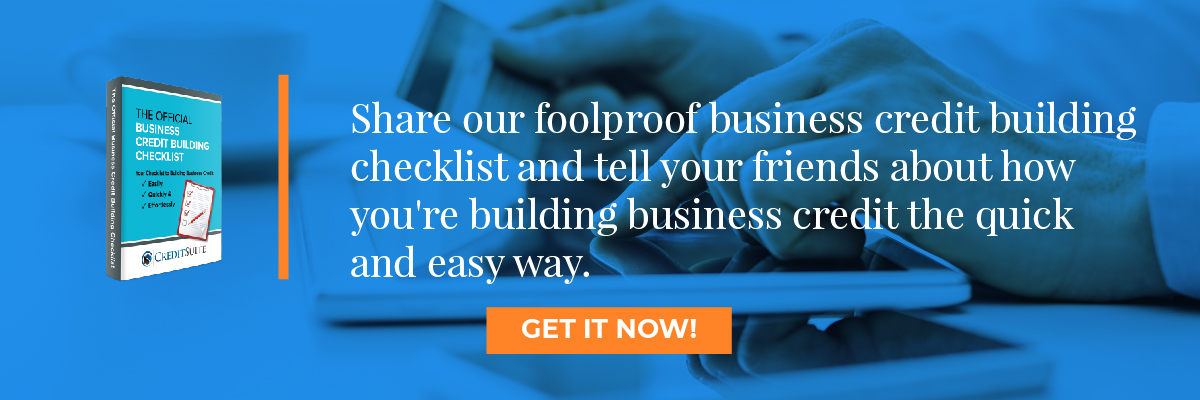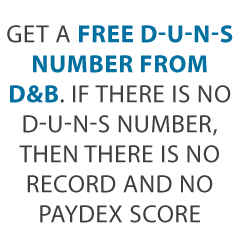- Connect With Us!
- (877) 600-2487
- info@creditsuite.com
What Your D&B Credit Report Says About You – Secrets Revealed
Published By Janet Gershen-Siegel at September 20th, 2017
What Your DB Credit Report Says Matters – We Go Above and Beyond to Get You the Skinny
Do you have any idea what your DB credit report says?
If your business has a DUNS number, then it also has a D&B (Dun & Bradstreet) credit report. If your business is brand new and just got its DUNS number, then expect that, soon, your small business will be the subject of a DB credit report. This in turn will showcase your business’s PAYDEX score. If you do you have ever wondered, just what is on a D&B report, then this article is for you.
What Your DB Credit Report Says
A Dun & Bradstreet Report (also known as a D&B Report) is a database-generated report. The business services giant produces such a report in order to help its clients in making decisions regarding new credit applications.
The main reason for a client using this kind of a report is to engage in credit risk monitoring of merchants, suppliers, and business partners. This helps companies make informed business credit decisions and steer clear of bad debt.
Dun & Bradstreet takes several factors into account in producing such a report. These include a predictor of payment delinquency; how financially stressed a company is versus comparable businesses; an assessment of supplier risk; credit limit recommendation; D&B rating; and PAYDEX score. Let’s consider all of these factors in turn.
What Your DB Credit Report Says: A Sample Report
As with all of your other business credit scores, you need to keep on top of your PAYDEX score. Dun & Bradstreet helpfully provides a sample report and even some higher level guidance in how to interpret it. It may be easiest to follow along with the report in one tab and this article in another.
Share our foolproof business credit building checklist and tell your friends about how you’re building business credit the quick and easy way. Know what your DB credit report says – and more!
Header and Executive Summary
The report starts off with basic identifying information. This includes your company’s name and address, its founding date and the number of employees. This section includes sales, working capital, and net worth.
This portion also shows your D&B rating, which is a graphical representation of how your business is doing, credit-wise. Furthermore, the section includes your business’s PAYDEX score, and a Predictive Analysis section to show how your company does with financial stress and credit risk as compared to other, similar companies. There is also a graph showing a credit limit recommendation by risk category (high, moderate, or low), and a composite D&B Viability Rating. Plus there is a business summary and a credit capacity summary section.
Specifics
The Viability Rating puts together basic information about your company profile (that is, if your financial data is available), a data depth indicator (this is a measurement of how good the data is on your company and how complete it is), a portfolio comparison (again, this is a comparison to similar companies), and then a viability score.
Dun & Bradstreet also helpfully provides information on how to read its various scores.
If you read nothing else in your D&B credit score report, read this section.
Business History
This section includes narrative information about your company. This includes the name(s) of its officer(s) and director(s), along with any affiliate information, if that applies. Your business registration section shows where the company is incorporated and its date of incorporation.
Government activity summary
This part is mainly about whether your business could be considered for socioeconomic programs, such as whether it is minority-owned or is considered a small business.
Share our foolproof business credit building checklist and tell your friends about how you’re building business credit the quick and easy way. Know what your DB credit report says – and more!
Operations data
This portion of your DB credit report shows basic company information like the business you are in, any net payment terms you have with creditors, your number of employees, the type of facilities you have, and where the facilities are (such as if they are within a business district or the like).
Industry data
This portion of your DB credit report defines the SIC and NAICS codes for your small business.
Family tree
Your main branch has a listing here. If your company has subsidiary offices, this is where they are listed, too.
Financial statements
This part sets off several data points for the past three years; these include current assets and liabilities, in an area called the Three Years Comparative Statement. In the Key Business Ratios section, the report compares your company to the industry median and the industry quartile when it comes to particular data points. These include short term solvency and assets sales.
The Most recent financial statement part shows detail on your company’s current assets, non-current assets, current liabilities, and non-current liabilities.
Indicators
The Public filings summary portion summarizes the number of judgments, liens, suits, and UCC filings your company has. The Public filings part shows a bar chart based on the previous portion.
Full filings
Here are the details on any judgments, liens, or UCC filings against your company.
Share our foolproof business credit building checklist and tell your friends about how you’re building business credit the quick and easy way. Know what your DB credit report says – and more!
Commercial credit score
In the Summary part, the report shows a graph from high to average to low for your company’s credit risk. The Incidence of delinquent payment section compares your company’s delinquent payment history to similar companies. The Credit score percentile norms comparison part graphs your company’s credit score as opposed to similar companies.
D&B Rating
A D&B Rating is designed to help companies rapidly gauge a business’s size and composite credit appraisal. The rating is based upon information in a company’s interim or fiscal balance sheet, and also an overall evaluation of the firm’s creditworthiness.
Rating Classifications
5A to HH Rating Classifications show company size based on worth or equity as computed by Dun & Bradstreet. The figure is important because a company’s size can be an effective indicator of credit capacity. Dun & Bradstreet assigns such ratings to businesses which have supplied a current financial statement.
Delinquency Predictor
Dun & Bradstreet uses predictive models to ascertain how likely a company is to be late with its payments. Predictive scoring is a means of using historical information in order to attempt to predict future outcomes. It involves identifying the risks inherent in a future decision. It does this by examining the relationship between historical information and the future event.
This represents an objective and statistically derived counterpart to subjective and intuitive assessments. Such scoring enables a business to rank and order accounts based on the probability of an event taking place, such as delinquent payments. However, note that Predictive Scoring only exemplifies a statistical probability, and not a guarantee.
Supplier Evaluation Risk Rating
The Supplier Evaluation Risk Rating (also called a SER Rating) calculates how likely it is that a company will get legal relief from its creditors or end its operations without paying creditors in full over next twelve months. The SER rating comes from D&B’s Financial Stress Score. The Financial Stress Score percentile serves as the basis for the SER Rating.
Once the Financial Stress Score percentile is calculated for a company, a second set of rules are applied to figure the SER Rating. The SER Rating provides a probability of worldwide supplier failure. Local nations’ failure ratings are indicated via a Class of 1 – 9. A 1 represents businesses with the lowest probability of supplier failure. A 9 represents companies with the highest probability of supplier failure.
Credit Limit Recommendation
A D&B Credit Limit Recommendation includes two recommended dollar guidelines:
- A conservative limitation, recommending a dollar benchmark if a company’s policy is to extend less credit to decrease risk and
- An aggressive restriction, proposing a dollar benchmark if a firm’s policy is to extend more credit with potentially more risk.
These dollar guideline amounts are based on a historical evaluation of the credit demand of customers in the U.S. payments database who have a similar profile to the business being evaluated, with respect to employee size and industry. The guidelines do not address if a specific business can pay that amount or if a particular client’s total credit limit was achieved.
Each set of limits comes with an assessment of the risk category a business falls into, or D&B’s assessment of how likely they are to continue to pay their obligations within the agreed-upon terms and how likely they are to go through financial stress in the next twelve months.
Composite Credit Appraisal
This is a number, 1 through 4, and it comprises the second half of a firm’s rating. It reflects Dun & Bradstreet’s overall assessment of that business’s creditworthiness. Dun & Bradstreet’s analysis of company payments, financial information, public records, business age and other important factors, when available, are interpreted in order to generate a Composite Credit Appraisal.
When a company does not supply current financial information, they cannot get a Composite Credit Appraisal rating of better than a 2. Moreover, the 1R and 2R Rating categories indicate company size based on the total number of employees for the business.
Specifics
These rating classifications are assigned to company files which do not include a current financial statement. Employee Range (ER) Ratings apply to certain lines of business not lending themselves to classification under the D&B Rating system. These kinds of businesses are assigned an Employee Range symbol based upon the number of employees and nothing else.
As a whole, when Dun & Bradstreet does not have all of the information they need, they will indicate as much in their reports. However, the absence of some pieces of information does not necessarily mean a certain firm is a poor credit risk.
Financial stress score
The Summary graph shows your company’s financial stress class from high to average, to low.
The Financial stress score percentile section shows the probability of failure of your business.
The Financial stress percentile comparison part graphs your company’s financial stress percentile versus similar companies.
Dun & Bradstreet produces Financial Stress Scores to predict the chance of business failure over the next twelve months. D&B defines business failure as a company which gets legal relief from its creditors; ceases its business operations without paying off all of its creditors in full; voluntarily withdraws from its business operations thus leaving unpaid obligations; enters into receivership or reorganization; or makes some type of arrangement for the benefit of its creditors, based upon the information found inside D&B’s commercial database.
The score ranges from 1,001 to 1,875. A score of 1,001 stands for the highest probability while a figure of 1,875 exemplifies the lowest probability of business failure.
Financial Stress Score Percentile
A Financial Stress Score Percentile is shown as a 1-100 ranking where a 1 percentile has the highest probability of failure and a 100 percentile has the lowest probability of failure.
A financially stressed company is specified as a firm which has ceased operations following assignment of bankruptcy; voluntarily withdrawn from business operation leaving unpaid obligations; ceased operations with loss to creditors; or is in receivership or reorganization, or has made some sort of an arrangement for the benefit of its creditors.
Financial Stress Percentile
The Financial Stress Percentile compares the company in question to other businesses in the same region, business sector, number of employees, or number of years in the business. Financial Stress Score Norms show an average score and percentile for all organizations with similar demographic attributes. These Norms can be used in order to benchmark where this particular business stands in relation to the norm for its peer group.
Financial Stress Risk Class
This is a division of the scored universe into five distinct groups, ranging from 1 to 5. A 1 represents businesses which have the lowest probability of failure, while a 5 represents firms which have the greatest probability of failure.
This Class makes it so a customer can quickly segment their new and existing accounts into various risk segments. This is to identify suitable marketing or credit policies. For any businesses showed as being Discontinued at This Location; Higher Risk; or Open Bankruptcy, those records automatically get a 0 score.
PAYDEX Score
A PAYDEX Score is Dun & Bradstreet’s proprietary dollar-weighted numerical indicator of how a company has paid its bills over the past year. The score is based upon trade experiences reported to Dun & Bradstreet by various vendors. In addition, the D&B PAYDEX Score ranges from 1 to 100; higher scores signify a better payment performance.
Advanced PAYDEX + CLR
There are two graphs in the D&B PAYDEX portion:
- Up to 3 month D&B PAYDEX – Payment dates divide into greater than 120 days slow; 30 days slow; prompt; and anticipated.
- Up to 24 month D&B PAYDEX – this graph shows the same scale.
The Credit limit recommendation graph divides your business’s risk category into high, moderate, or low. The PAYDEX yearly trend line graph shows your company’s PAYDEX scores compared to the primary industry for the last four quarters. In the Payment habits portion, the report shows your small business’s percentage of payment within terms divided by various dollar ranges.
The Payment summary section provides some detail on any payment experiences D&B has on file for your business. This shows how quickly your company paid off its debts, how much credit was extended, and other pertinent information. The Detailed payment history portion expands upon the previous one by adding report dates, paying records, selling terms, and the like.
What Your DB Credit Report Says: Get your own D&B PAYDEX report
The best way to get a handle on your company’s overall financial health is to look at your own PAYDEX report. You can get your PAYDEX report here and, if you need to, you can contact their Customer Service department (it’s a part of Dun & Bradstreet, as they also generate PAYDEX reports) here. D&B’s PAYDEX Customer Service phone number is here.
What Your DB Credit Report Says: D&B Data
Finally, any report is only as good as the data it comes from. Dun & Bradstreet’s database contains over 250 million companies spanning the globe, which includes around 120 million active firms and about 130 million companies which are out of business but kept for historical reasons.
D&B constantly gathers data and works to improve its analyses to ensure the greatest degree of accuracy possible.

 " class="attachment-blog-single size-blog-single wp-post-image" alt="Get Business Credit Cards for New Businesses Credit Suite-Business Line of Credit Decoded" title="Get Business Credit Cards for New Businesses">>
" class="attachment-blog-single size-blog-single wp-post-image" alt="Get Business Credit Cards for New Businesses Credit Suite-Business Line of Credit Decoded" title="Get Business Credit Cards for New Businesses">>
